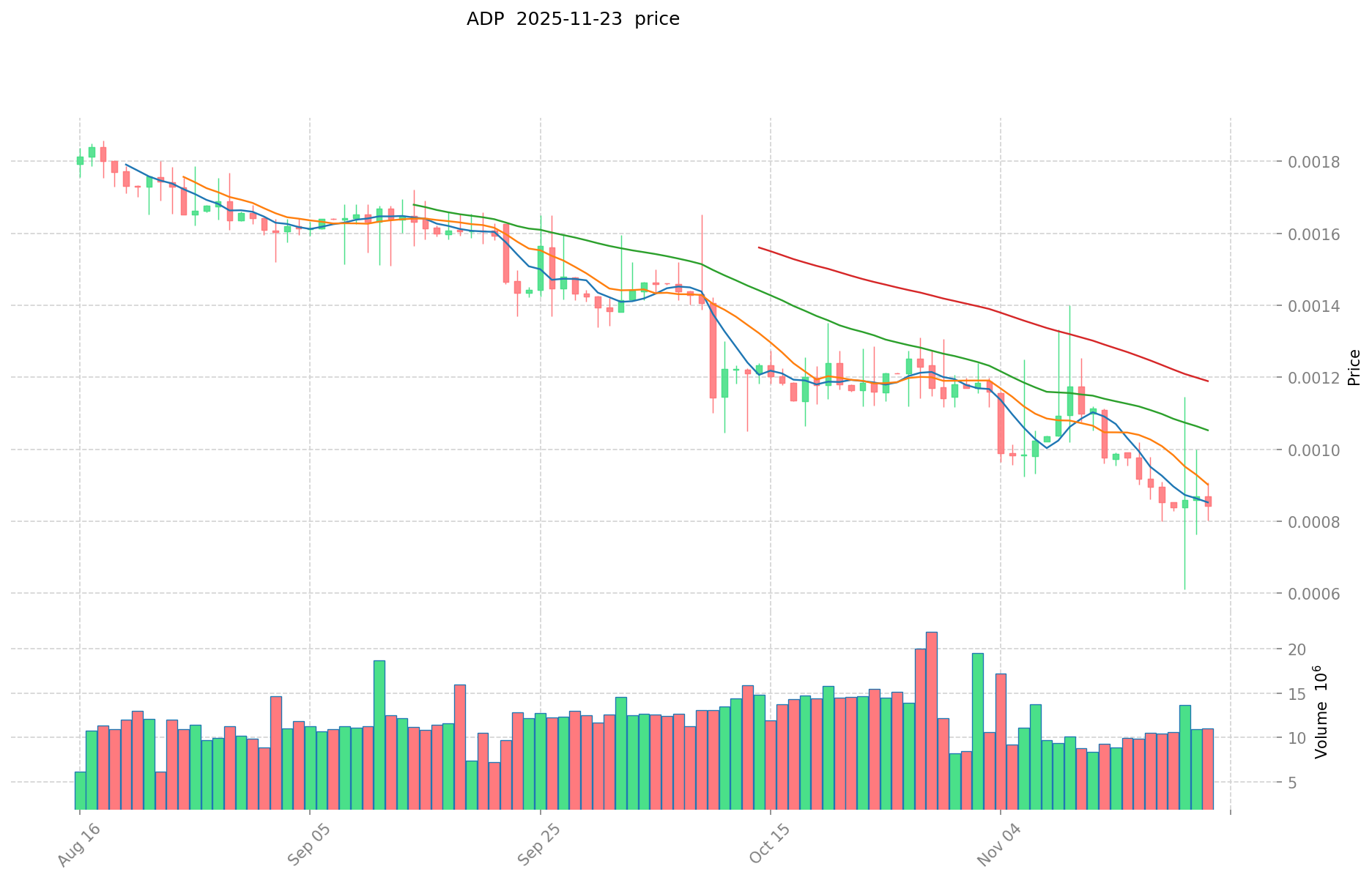What is ADP: Understanding the Role of Adenosine Diphosphate in Cellular Energy Transfer
Adappter Token's Positioning and Significance
In 2020, Adappter Token (ADP) was launched to address the challenges of fair distribution and user compensation in the blockchain ecosystem. As a platform for content partnerships and user engagement, Adappter plays a crucial role in the blockchain content and application industry.
As of 2025, Adappter Token has become an important asset in the blockchain content ecosystem, with a market capitalization of $3,765,988. The platform boasts 2,919 token holders and is actively traded on multiple exchanges, including Gate.com.
Origin and Development History
Birth Background
Adappter Token was created in 2020 to solve the issues of user compensation and fair distribution in the blockchain ecosystem. It emerged during the blockchain technology boom, aiming to contribute to the growth of industry and content by establishing a transparent and fair distribution system.
Adappter's introduction brought new possibilities for content creators and users in the blockchain space.
Important Milestones
- 2020: Main network launch, introducing the Activity Point (AP) system for user compensation.
- 2022: Price reached an all-time high of $0.158038 on March 18.
- 2025: Continued development and expansion of the Adappter ecosystem.
With support from the Adappter Alliance, the platform continues to optimize its technology, security, and real-world applications.
How Does Adappter Token Work?
Decentralized Control
Adappter Token operates on a decentralized network of computers (nodes) worldwide, free from central control by banks or governments. These nodes collaborate to validate transactions, ensuring system transparency and attack resistance, empowering users with greater autonomy and enhancing network resilience.
Blockchain Core
Adappter's blockchain is a public, immutable digital ledger that records every transaction. Transactions are grouped into blocks and linked through cryptographic hashes, forming a secure chain. Anyone can view the records, establishing trust without intermediaries.
Ensuring Fairness
Adappter uses a consensus mechanism to validate transactions and prevent fraudulent activities such as double-spending. Participants maintain network security through activities like staking or running nodes, and are rewarded with ADP tokens.
Secure Transactions
Adappter employs public-private key encryption to protect transactions:
- Private keys (like secret passwords) are used to sign transactions
- Public keys (like account numbers) are used to verify ownership
This mechanism ensures fund security and maintains transaction privacy. Additional security features may include multi-signature capabilities or other advanced cryptographic techniques.
ADP's Market Performance
Circulation Overview
As of November 23, 2025, ADP's circulating supply is 4,473,201,118 tokens, with a total supply of 10,000,000,000.
Price Fluctuations
ADP reached its all-time high of $0.158038 on March 18, 2022.
Its lowest price was $0.00077575, recorded on November 21, 2025.
These fluctuations reflect market sentiment, adoption trends, and external factors.
Click to view the current ADP market price

On-Chain Metrics
- Daily Transaction Volume: $9,389.6970992 (indicates network activity)
- Active Addresses: 2,919 (reflects user engagement)
ADP Ecosystem Applications and Partnerships
Core Use Cases
ADP's ecosystem supports various applications:
- Platform Integration: Adappter SDK reduces development costs for partners.
- User Compensation: AP (Activity Point) system rewards user engagement.
Strategic Collaborations
ADP has established partnerships within its ecosystem, contributing to industry growth and content development. These partnerships provide a solid foundation for ADP's ecosystem expansion.
Controversies and Challenges
ADP faces the following challenges:
- Market Volatility: Significant price fluctuations, with a 53.08% decrease over the past year.
- Adoption: Expanding user base and increasing market cap in a competitive landscape.
These issues have sparked discussions within the community and market, driving continuous innovation for ADP.
ADP Community and Social Media Atmosphere
Fan Enthusiasm
ADP's community shows some activity, with:
- 2,919 token holders
- Listed on 3 exchanges
Social Media Sentiment
Social media sentiment around ADP is mixed:
- Supporters praise ADP's ecosystem integration and user compensation model.
- Critics may focus on the significant price decline over the past year.
Recent trends show a generally bearish sentiment due to the price performance.
Hot Topics
Users discuss ADP's role in blockchain-based content partnerships and its potential for fair distribution between enterprises and users.
More Information Sources for ADP
- Official Website: Visit Adappter's official website for features, use cases, and latest updates.
- GitHub: Explore Adappter's GitHub for technical details and development activities.
- Blockchain Explorer: Check ADP on Etherscan for transaction data and contract information.
ADP Future Roadmap
- Ecosystem Goals: Expand partnerships and increase adoption of the Adappter platform.
- Long-term Vision: Become a leading intermediary for eco-chain content partners through blockchain technology.
How to Participate in ADP?
- Purchase Channels: Buy ADP on Gate.com
- Storage Solutions: Use secure Ethereum-compatible wallets for storing ADP
- Ecosystem Participation: Engage with the Adappter platform to earn AP (Activity Points)
- Development: Utilize the Adappter SDK to integrate with the ecosystem
Summary
ADP, through Adappter's blockchain technology, is redefining content partnerships and user compensation in the digital ecosystem. It offers transparency, fair distribution, and reduced development costs for partners. While facing challenges such as market volatility and adoption, ADP's innovative approach to user engagement and ecosystem development positions it uniquely in the decentralized technology landscape. Whether you're a newcomer or an experienced player, ADP and the Adappter platform are worth watching and participating in for their potential in reshaping digital content partnerships and user rewards.
FAQ
What is ADP and what does it do?
ADP (Automated Data Processing) is a blockchain protocol that automates data processing and analysis in decentralized networks. It enhances efficiency and security in Web3 applications.
What is ADP in biology?
ADP in biology stands for Adenosine Diphosphate, a key molecule in cellular energy transfer and metabolism.
What is ADP in payroll?
ADP (Automatic Data Processing) is a leading provider of payroll services and HR solutions. It offers automated systems for processing employee paychecks, managing benefits, and handling tax filings for businesses of various sizes.
What is my ADP used for?
ADP (Automated Data Processing) tokens are used for governance, staking, and accessing premium features within the ADP ecosystem. They enable holders to participate in decision-making and earn rewards.
Share
Content